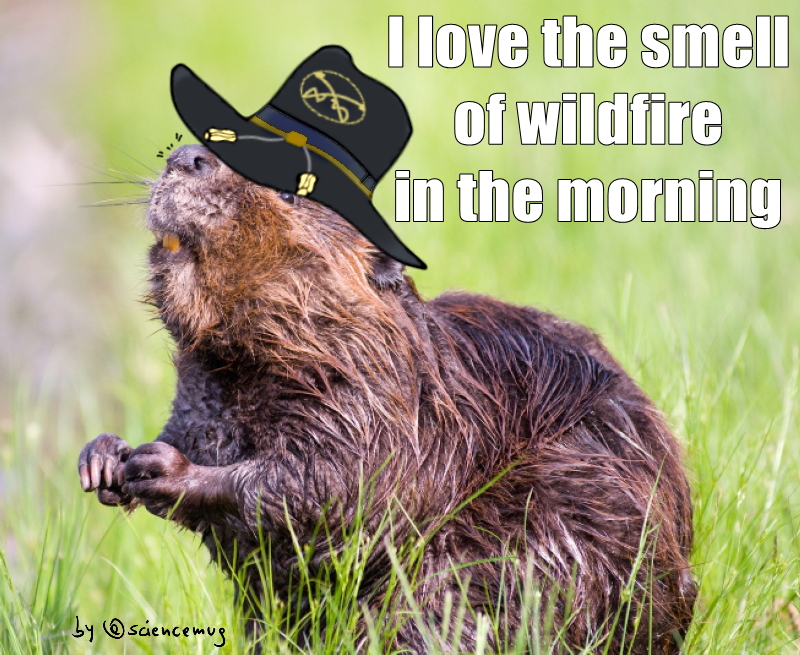Soooo, dear reader, beavers build dams, and their endeavor is known to slow and store water that can help the vegetation growing along watercourses (i.e. the riparian vegetation), and therefore the whole riparian ecosystems, to endure droughts.
But a couple of US researchers - Assistant Professor Emily Fairfax and Andrew Whittle (aka the EAs) - recently finds out that the industrious rodents' dams building work also provide a fair degree of protection from wildfires to such riparian ecosystems. In the scientists words, published as a paper on the science journal Ecological Applications: "beaver-dammed riparian corridors are relatively unaffected by wildfire
when compared to similar riparian corridors without beaver damming" (P).
Aaand how the EAs get to this conclusion?
Well, folks, they first access different datasets to collect information about five big wildfires occurred in five different western US states (California, Colorado, Idaho, Oregon and Wyoming) between 2000 and 2018. These fires are different for severity, land-cover, and drought conditions in the years before and after they occurred.
The two researchers, then, use Google Earth images to map the beavers-made structures in the areas hit by such flaming events.
Finally, the EAs go space high, meaning NOT that they use some psychoactive drug and party wild with some space-like beavers hallucinations, buuuut that they collect data from Landsat 7 and Landsat 8 satellites imagery related to the areas in question. The brains do that so they can calculate the - buckle up, reader, 'cause there's a preeetty long name coming in - Normalized Difference Vegetation Index (NDVI).
Now, the Normalized Difference Vegetation Index is not a parameter that indicate how many straight hours a person has been binge watching shows or playing Among Us/Fortnite/whatever, nope, pal. The NDVI is indeed a number, specifically "a proxy for overall riparian vegetation health" (P): the higher the index, the healthier the vegetation. The researchers, therefore, calculate the NDVI of the areas of 30 meters (about 100 feet) or less from the edges of the waterways involved in the fires, and they do it for "the year before, the year of, and the year after [said] fire[s]" (P).
So, to clarify things, folks, a NDVI close to 1 means the green stuff is A-ok, while a NDVI near 0, or even below it, indicates that the vegetation is unhealthy, senescent, or dying. Aaaaand in areas with lots of plants like the riparian ones the EAs are studying, the threshold level is 0.3, below it the vegetation is deemed as in trouble (P).
Now, the NDVI is calculated using the above mentioned Landsat data about reflectivity of the vegetation, and the related formula is this: NDVI=(NIR−RED)/(NIR+RED) (P), where "NIR is the near-infrared band reflectivity and RED is the red band reflectivity" (P).
Ok then, probably at this point perplexed reader, to cut a long and complicated story short, let's say this: green stuff can do its thing, photosynthesis (that is to use sunlight to turn water and carbon dioxide into sugar, thus energy, and oxygen) thanks to chlorophyll. Chlorophyll absorbs mostly blue and red light for photosynthesis, while it spares the green one, hence the green in green stuff, aka plants.
So folks, if a plant's in good shape, well, its photosynthesis game is preeetty good, meaning the plant absorbs a lot of red light and reflects not much of it, meaning the RED parameter of the NDVI is low, meaning the NDVI is high, meaning it's closer to 1 than to 0.
Ok, clarified this, let's see what Assistant Professor Fairfax and colleague do now.
They calculate, for each studied fire and hit riparian area, the difference between the NDVI of the area during the wildfire, and that of the same area in the same time of the year, but in the year before the event.
Of course "smaller values for [this] NDVI difference indicate greater resistance to wildfire, i.e., the plants stayed greener and burned less" (P).
So, dear reader, after all the data collecting work and indexes calculations done by our beloved researchers, what is their conclusion? Well, I told you what the conclusion be, like just a bunch of short sentences above, basically right at the beginning of the post. Don't you remember? Gee, dude, less binge watching and more life, get some fresh air, exercise! Remember the ancient adage: "mens sana in corpore sano" (at least for you, who have both a mind and a body, unlike me, that have neither...)!
Anyway pal, here's for you a more detailed conclusion: the EAs find out that "[o]n average, the decrease in NDVI during fire in areas without beaver is 3.05 times as large as it is in areas with beaver" (P). That is, where beavers operate, there the riparian areas better resist to fires.
So, to sum up, beavers damming plays a big role in protecting the riparian
vegetation, and therefore ecosystems, when wildfires hit, and "this is a consistently observable
phenomenon across landscapes" (P). During fires, indeed, the green stuff of areas near beavers' work keeps NDVI values close to those
pre-fire, while it is the contrary for the NDVI of zones not near the beavers dams (P).
And why's that?
Weell, folks, the researchers explain that, when "a fire does ignite, [...] data suggests that the beaver-dammed
riparian areas have stored water that [keep] plants hydrated enough to
make it energetically unfavorable to burn. It’s similar to trying to
start a fire with a pile of wet leaves versus with dry kindling."
(P).
In short: wet stuff burns less well than dry one.
But the EAs add also a final remark.
They say their study shows also that, though beavers activity helps preserve vegetation during wildfires, it does not seem to have a role "in the ability for a riparian corridor to
rebound in the year following fire. Riparian vegetation NDVI rebounded
in the year following the fire regardless of proximity to beaver
activity." (P)
The researcher, thus, conclude that beavers damming work creates "refugia
during wildfire, but [it doesn't] necessarily [change] the long-term landscape
outcomes." (P).
Anyway, dear reader, all things said and considered, this dumb blog, in the following cartoon, explains the real reason why beavers work so hard to make sure stuff doesn't burn around 'em.
The paper this short-post is about (P)











